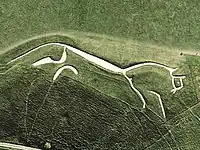Tag:archaeological_site=geoglyph
 |
| Description |
|---|
| To specify an archaeological site as a geoglyph |
| Group: historic |
| Used on these elements |
| Requires |
| Useful combination |
|
| Status: in use |
| Tools for this tag |
|
Under favourable climatic conditions, geoglyphs can survive for long periods of time without being erased by denudation processes. Prehistoric geoglyphs often depict animals, for example: monkey, anteater, condor, lizard, moose, flamingo, frigate bird, dog, hummingbird, dragonfly, parrot, pelican, horse, snake, spider and whale. There are also depictions of trees and flowers. Certain meanings are often associated with the images.
- See also Geoglyph on Wikipedia
How to map
Set a node ![]() or draw as an area
or draw as an area ![]() along the outline.
along the outline.
Tag it with
Tags to use in combination
wikipedia=*- a link to Wikipedia's articlewikidata=*- an ID of the specific Wikidata itemhistoric:civilization=*(or more precise subtags) - the civilization (culture) that originally created the featuretourism=attraction- if it is a tourist attraction.heritage=*- if it is registered by an official heritage organisation.
See also
archaeological_site=rock_paintingis for painting on the rock surface only.archaeological_site=petroglyphman_made=geoglyph- modern geoglyph